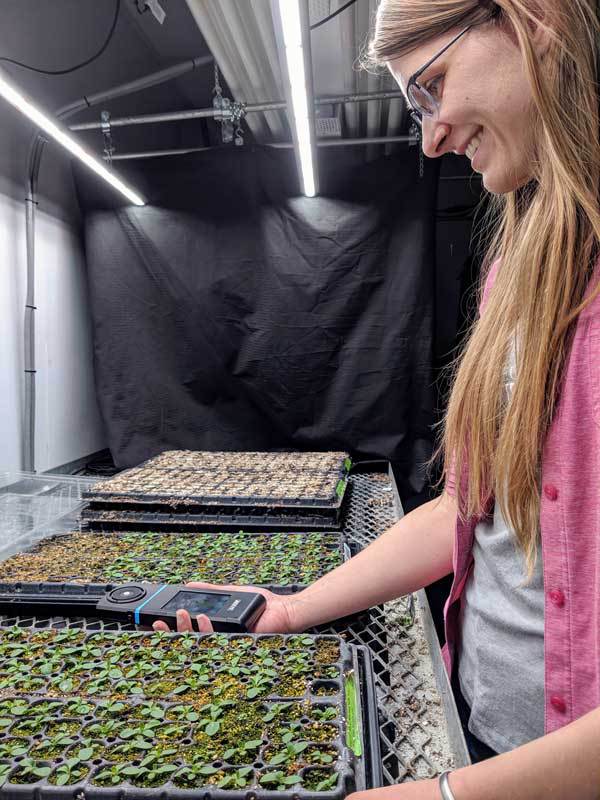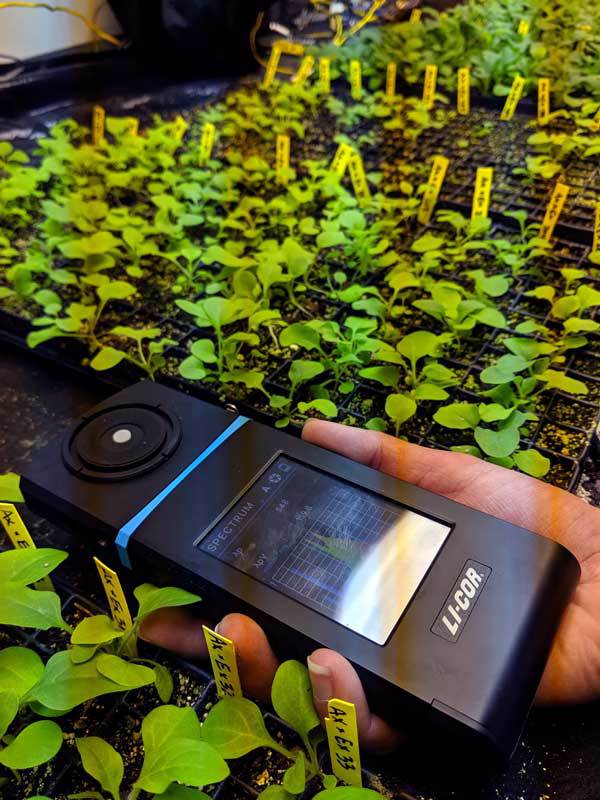Growing Research, Responsibility, and Relationships at Michigan State
When Dr. Roberto Lopez returned to Michigan State University as a faculty member in 2016, it was with a 45% research, 30% teaching, and 25% extension appointment. With his appointment, Dr. Lopez has an opportunity to impact lives across a spectrum of backgrounds, such as graduate students Kellie Walters and Annika Kohler, both of whom are performing research in his lab.
Dr. Lopez has spent more than 15 years researching the effects of lighting on controlled environment horticulture. He has been studying the effect of light intensity, quality, and photoperiod on greenhouse and indoor production.
Now, in his lab in the Department of Horticulture, Dr. Lopez and his students have focused their research on the effect of supplemental, sole-source, and photoperiodic lighting during propagation and production of young specialty crops, including floriculture, leafy greens, and herbs. Their research is especially important to the continued growth and support of Michigan’s large greenhouse industry.
In order to accurately study supplemental, sole-source, and photoperiodic lighting, Dr. Lopez and his lab must be able to reliably measure light spectra and intensity, modify each as needed, and then verify those modifications. One instrument they rely on to measure light is the LI-COR LI-180 Spectrometer. Dr. Lopez has found the spectrometer to be a unique instrument to help him fulfill his teaching, research, and extension needs.
Research
Part of what Dr. Lopez’s lab does is examine the effect of varying intensities and spectra have on plant growth, development, and morphology. The primary goal of their research is to reduce energy costs while improving quality and yield. For instance, Walters is determining how light intensity influences the flavor of culinary herbs. The study examines how light intensity and carbon dioxide influence volatile compounds to produce better tasting basil.
Another study is looking at the effects of blue light on perennials. The red to far-red light ratio provided by incandescent lamps is known to induce perennials into flower but will also cause stem elongation. They’ve found that an intermediate blue light intensity can be substituted for far-red light to induce flowering while limiting elongation. In order to “determine exactly how many micromoles of blue light and how many micromoles of red light we’re providing,” Dr. Lopez and his lab use the LI-180.
Whether they’re fine-tuning the flavor of basil or substituting wavelengths to influence plant morphology, controlling light is critical for Dr. Lopez and his lab. Adjustable LED fixtures play a big role in both spectra modification and reducing energy costs. But Dr. Lopez insists tuning the lights isn’t as simple as just telling the fixtures what to do. “You can’t just say ‘at this height, I want to have 15 micromoles of blue light.’ You can only increase (or decrease) the amount. Having the spectrometer right there to tell us what the intensity is, is great.”
A spectrometer that provides near instant measurements reduces the amount of time spent tweaking the lamps, and measurements that take several hours with other instruments can instead be done in minutes. They can make a modification, measure, and readjust as necessary, in little time. That leaves more time for interpreting the data and generating new ideas.
Teaching
Finding meaningful ways for students to apply the science discussed in lecture is especially important for the learning process. Dr. Lopez ensures that students help out and take part in experiments being run throughout the year. Using the spectrometer students can make modifications, measure them, and see how those modifications have changed the light. For Walters, using the LI-180 gives her “additional data that helps me tell the story.”
The students can also test their modifications quickly. They don’t have to wait several minutes between measurements. Dr. Lopez appreciates being able to quickly capture measurements and “see the graph in color and get the intensity.” The intuitive interface and speed help keep students focused and engaged.
“[Other instruments] were time consuming and difficult to use. You had to have a laptop and software system to see your measurements – it’s a lot of interface time,” Kohler said. “The LI-180 made it easy to figure out what I wanted with the lights. It’s really user friendly.”
Since the instrument is easy to use, Dr. Lopez can trust his undergrad students with the responsibility of taking measurements themselves, including night measurements.
This is good for both Dr. Lopez and his students. Entrusting students with the responsibility of taking measurements empowers them and frees Dr. Lopez up for other tasks. It also provides students with valuable experience they will need at the next level in their education or career.
Extension
Michigan is home to the 3rd largest greenhouse industry ($480 million) in the United States. Low light levels, due to the state’s northern latitudes and cloud cover, necessitate the use of supplemental lighting. As a member of the Floriculture Research Alliance, the MSU Floriculture & Greenhouse Crop Production Team, and Electronic Growers Resources Online (e-GRO), Dr. Lopez, and his lab, are invested in sharing their research with greenhouse growers so that they can apply it to their production.
Growers moving to LEDs is vital for reducing energy costs and potentially improving quality and yield. A big advantage of using LED fixtures with the LI-180 is the deployment of lighting strategies or light “recipes,” such as the research Walters has been doing on basil. Walters’ primary goal with her research is to be able to “provide resources. To talk to a grower and say ‘If you want this outcome, you should try this.’ To consult with growers and to provide them a framework for improving yield and plant quality.”
Dr. Lopez notices “a lot of growers are investing in LEDs and oftentimes, they’ll ask ‘What can I purchase to measure the light quality of my LEDs?’” He recommends an easy-to-use, handheld spectrometer such as the LI-180.
The problem, as Dr. Lopez sees it, is that when making the investment into LEDs “the manufacturer will tell them ‘You only have red and blue light’ but they won’t tell them its 87% red and 13% blue.” For him, the spectrometer is a tool growers can use for output verification.
Dr. Lopez and his lab not only provide the latest science for growers but they have personal experience using an instrument they see as an asset to a greenhouse. Their research and experiences allow them to further demonstrate how new technology and techniques can be adopted to help optimize greenhouse efficiency.
Final Thoughts
Empowering and inspiring the next generation of researchers is as important as continuing to make new discoveries and fostering relationships in the grower community. All are seeds for the continued advancement of science and growth of the greenhouse industry, both in Michigan and abroad. Dr. Lopez’s appointments at MSU afford him the opportunity to have a significant impact across all three, and we at LI-COR are happy to be a part of his success.

